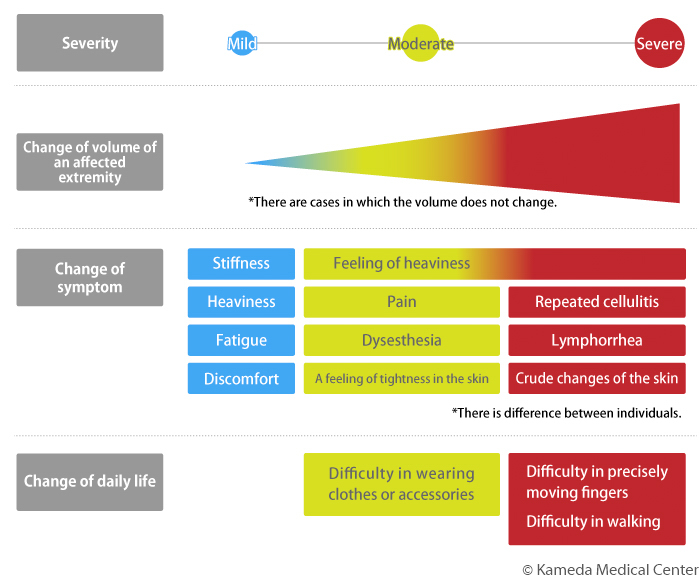4.Proceeding of lymphedema and changes of the symptoms
In an affected extremity with lymphedema, the volume gradually increases in accordance with exacerbation in general. However, while some cases of lymphedema have already been moderate or severe at the time when some bilateral deference of the volume is found, the other cases have scarcely any bilateral difference even if lymphedema is moderate or severe. Therefore, it is important to consider symptoms other than changes of the volume.
Early detection of lymphedema is preferable. However, in many early cases, because no obvious symptom occurs or there are only relatively mild symptoms including mild stiffness, listlessness, fatigue, or a vague uncomfortable feeling of an affected extremity, most patients do not notice that lymphedema occurs.
With progression to a moderate stage, the following various symptoms may occur: dysesthesia such as heaviness, pain, or ache of an affected extremity, a feeling of oppression of the skin, decreased tenderness of the wrist/ankle, and decreased grip strength of the hand. Also, patients notice the following changes in daily life: a feeling of tightness when wearing clothes, difficulty in putting on ring/wristwatch/bracelet, difficulty in wearing shoes, difficulty in sitting on the heels of one's feet.
With progression to a more severe stage, the following disabilities in daily life may occur: inability for fingers to move precisely, difficulty in holding chopsticks, difficulty in climbing stairs, difficulty in walking. In addition to that, the most remarkable point is that the skin roughly changes, lymph fluid is discharged from the skin, or cellulitis (infection) often occurs in an affected extremity.
It is important to always pay attention to the above changes of symptoms accompanied with progression of lymphedema. Therefore, in order to prevent further progression, a routine examination/test for lymphedema is extremely crucial for not only patients with lymphedema who have already started conservative therapy, but also patients without lymphedema whose lymph nodes had been removed at surgery for cancer with high risk of lymphedema.
